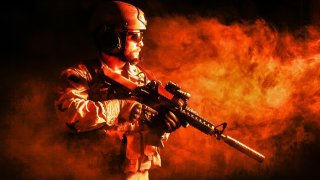Nothing Can Stop the U.S. Navy SEALs
The U.S. Navy SEALs, officially formed in 1962, have roots that stretch back to World War II, evolving from covert amphibious reconnaissance units. Over the years, SEALs have become the tip of the spear in U.S. military operations, taking part in missions from Vietnam to Afghanistan.
3 Key Points: The U.S. Navy SEALs, officially formed in 1962, have roots that stretch back to World War II, evolving from covert amphibious reconnaissance units. Over the years, SEALs have become the tip of the spear in U.S. military operations, taking part in missions from Vietnam to Afghanistan.
-However, their raid on Osama bin Laden's compound in 2011, known as Operation Neptune Spear, propelled them to legendary status.
-This high-profile operation, where SEAL Team Six eliminated the world’s most wanted terrorist, showcased their unparalleled skill in unconventional warfare, solidifying the SEALs as America’s premier special operations force.
Navy SEALs: The Untold History Behind America’s Premier Special Forces
The Navy SEALs are at the pinnacle of U.S. special forces – the most elite members of the world’s most elite fighting force. Tasked with the most sensitive and demanding military operations, SEALs have long since entrenched themselves in the public’s imagination. But it wasn’t until Operation Neptune Spear, SEAL Team Six’s successful raid on Osama bin Laden’s compound in Pakistan, that the SEALs ascended to something like mythical status.
Never out of the fight
While not officially formed until 1962, the SEALs began in spirit during World War II, when the U.S. identified the value of covert, amphibious reconnaissance. The first iteration of what would become the SEALs were the Scouts and Raiders, who were trained to perform reconnaissance on landing beaches and coastal defenses. They were first deployed to North Africa and the Mediterranean during World War II’s Operation Torch.
Soon the Navy began training a group of its sailors in the art of demolitions, explosive cable cutting, and commando raiding techniques in what was known as the Naval Combat Demolition Units (NCDUs). The newly minted NCDUs would deploy to England in time to assist with the Allied invasion at Normandy. The U.S. soon recognized a need for underwater demolition and began training Underwater Demolition Teams who contributed in island-hopping efforts across the Pacific against Imperial Japan.
The only easy day was yesterday
The SEALs as we knowthem today would not form until 1962, when President John F. Kennedy, recognizing the challenges of countering guerrilla warfare tactics in Southeast Asia, committed to strengthening the U.S. special forces.
After forming, the SEALs would become a fixture of U.S. warfighting. From Vietnam to Panama to Afghanistan, the SEALs have been on site, providing counterterrorism, special reconnaissance, hostage rescue, counternarcotics, underwater demolition, special training, direct action, or whatever else happens to be needed.
It pays to be a winner
In the storied history of the SEALs, much of which has transpired beyond the view of the general public, one operation stands apart as the most prominent – Operation Neptune Spear.
On May 2, 2011, SEAL Team Six assassinated Osama bin Laden at his secret compound in Abbottabad, Pakistan. Bin Laden had been in hiding ever since slipping away from approaching US forces at Tora Bora, and had been the world’s most wanted fugitive since orchestrating the terrorist attacks of September 11th.
The raid was massively popular amongst the US public, with bin Laden’s death perceived as something of a catharsis. But the killing was not without controversy. Bin Laden was unarmed, and to reach him, the Americans had violated the territorial integrity of a sovereign nation. Regardless, the successful raid earned the SEALs a vaunted reputation as America’s premier unconventional war fighters.
About the Author: Harrison Kass
Harrison Kass is a defense and national security writer with over 1,000 total pieces on issues involving global affairs. An attorney, pilot, guitarist, and minor pro hockey player, Harrison joined the US Air Force as a Pilot Trainee but was medically discharged. Harrison holds a BA from Lake Forest College, a JD from the University of Oregon, and an MA from New York University. Harrison listens to Dokken.
Image Credit: Shutterstock.


